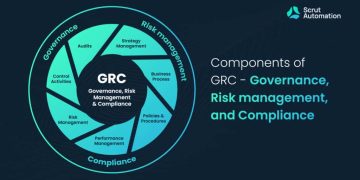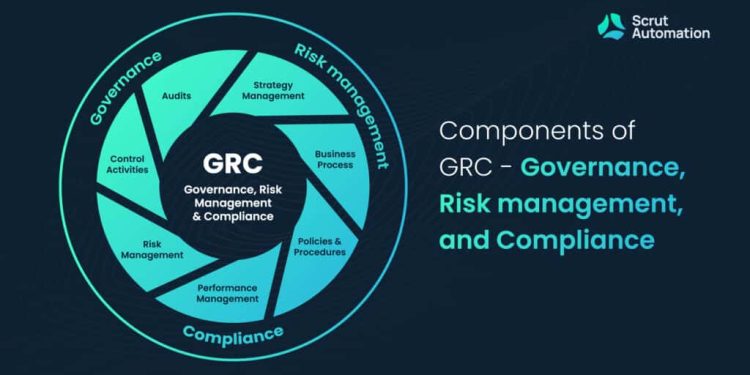In the realm of cybersecurity and data protection, the importance of Governance, Risk, and Compliance (GRC) software cannot be overstated. GRC software serves as a linchpin in fortifying organizations against evolving cyber threats and safeguarding sensitive information.
One of the pivotal roles of GRC software is its ability to align processes within an organization while effectively mitigating risks associated with cybersecurity vulnerabilities. By integrating governance, risk management, and compliance functionalities, GRC software offers a comprehensive approach to managing and addressing cybersecurity challenges.
Furthermore, in the face of ever-changing regulations and the complexity of data security landscapes, GRC software emerges as a critical tool for ensuring adherence to legal requirements and industry standards. This proactive approach not only enhances data protection but also minimizes potential vulnerabilities that could expose organizations to breaches.
For organizations seeking structured processes to navigate the intricate domains of governance, risk management, and compliance, embracing GRC software is imperative. It empowers entities to stay abreast of regulatory changes, bolster cybersecurity resilience, and instill a culture of proactive risk mitigation to safeguard their data assets effectively.
Understanding GRC software and its core functions
In today’s dynamic business landscape, aligning governance, risk management, and compliance has become increasingly crucial for organizations striving for robust cybersecurity and data protection. GRC software stands at the forefront, offering a comprehensive solution that integrates these critical functions into a unified platform to bolster organizational resilience. Let’s delve into the core functions of GRC software and its pivotal role in fortifying cybersecurity frameworks.
GRC software plays a pivotal role in streamlining governance processes by providing organizations with the tools to establish structured frameworks. These frameworks empower entities to define roles, delineate responsibilities, and set decision-making protocols. By implementing GRC solutions, organizations can ensure effective cybersecurity governance by creating a clear line of accountability, fostering transparency, and enhancing operational efficiency.
One of the key functions of GRC software lies in enhancing risk management capabilities. By leveraging GRC tools, organizations can effectively identify, assess, and mitigate cybersecurity risks that pose significant threats. These software solutions aid in prioritizing risks, enabling proactive monitoring, and facilitating swift responses to cyber threats. Through GRC software, organizations can fortify their risk management strategies and bolster resilience against evolving cyber challenges.
GRC software serves as a stalwart ally in ensuring regulatory compliance by assisting organizations in adhering to pertinent regulations and compliance mandates. Whether it’s GDPR, HIPAA, or industry-specific standards, GRC solutions provide a structured approach to maintaining regulatory alignment. By leveraging GRC software, organizations can safeguard sensitive data, uphold data privacy standards, and navigate the complex regulatory landscape with ease.
GRC software embodies a versatile suite of functionalities that converge governance, risk management, and compliance into a cohesive framework. By embracing GRC solutions, organizations can bolster their cybersecurity posture, streamline operational processes, and elevate their resilience against cyber threats. As the digital landscape continues to evolve, GRC software stands as a beacon of comprehensive cybersecurity governance, empowering organizations to navigate the complexities of data protection with confidence and efficacy.
Integration of GRC Software for cybersecurity resilience
In today’s rapidly evolving digital landscape, the integration of Governance, Risk, and Compliance (GRC) software is essential for organizations aiming to fortify their cybersecurity resilience. By seamlessly incorporating GRC tools into their cybersecurity strategies, businesses can proactively address emerging cyber threats and align their security practices with overarching business objectives.
Automating security monitoring and reporting
GRC software plays a pivotal role in automating security monitoring and reporting functions, revolutionizing how organizations track and manage their cybersecurity posture. Through advanced automation capabilities, GRC solutions diligently monitor security controls, swiftly detect anomalies, and generate comprehensive reports on cybersecurity performance. This automated reporting not only enhances visibility into potential vulnerabilities but also empowers timely responses to security incidents, allowing swift mitigation actions to be implemented.
Facilitating incident response and recovery
An integral aspect of cybersecurity resilience is efficient incident response and recovery, where GRC software excels in supporting organizations through every phase of the process. From incident identification to containment, eradication, and recovery, GRC solutions streamline incident handling procedures. By enabling swift and coordinated responses, GRC tools help minimize the impact of cybersecurity incidents on organizational operations, ensuring business continuity and safeguarding critical assets.
Integrating GRC software into cybersecurity strategies is not just a proactive measure but a strategic imperative in today’s threat landscape. By leveraging the comprehensive capabilities of GRC tools, organizations can strengthen their cyber defenses, mitigate risks effectively, and enhance their overall resilience against evolving cyber threats.
Key considerations for selecting GRC software
When choosing GRC software tailored to cybersecurity and data protection needs, organizations must evaluate key factors to ensure seamless integration and efficient risk management. Here are essential considerations to guide decision-making:
Scalability and flexibility in GRC solutions
Scalability and flexibility are crucial aspects to consider when selecting GRC software. Organizations need solutions that can adapt to their growth trajectory and evolving cybersecurity challenges. Adaptable GRC software aligns with changing regulatory landscapes and security requirements, ensuring that the platform can grow in tandem with the organization’s needs. Scalable solutions enable seamless expansion without compromising on security measures, providing a robust foundation for long-term governance and risk management strategies.
Interoperability and integration capabilities
Interoperability and integration play a vital role in maximizing the effectiveness of GRC software. The software’s ability to seamlessly integrate with existing IT systems and security tools enhances data protection and cybersecurity operations across the organization. By facilitating smooth communication between various platforms and tools, GRC software streamlines processes and ensures comprehensive risk management. Organizations should prioritize solutions that offer strong integration capabilities to consolidate security efforts and promote a cohesive approach to governance and compliance.
In conclusion, selecting GRC software with a focus on scalability, flexibility, interoperability, and integration capabilities is paramount for organizations aiming to enhance their cybersecurity posture and data protection measures. By evaluating these key considerations, businesses can choose GRC solutions that align with their specific requirements and support their overarching governance and risk management objectives.
Conclusion
Implementing GRC software is a strategic move for organizations looking to fortify their cybersecurity and data protection efforts in a rapidly evolving digital landscape. By streamlining governance processes, enhancing risk management practices, ensuring regulatory compliance, and bolstering cybersecurity resilience, GRC solutions play a pivotal role in safeguarding sensitive information and preventing cyber threats. Leveraging GRC software not only provides a structured approach to managing governance and risk but also instills confidence in organizations to navigate complex regulatory landscapes effectively.
GRC software acts as a proactive defense mechanism, allowing organizations to identify and mitigate potential risks before they escalate into security breaches. By centralizing data protection efforts and implementing robust cybersecurity measures, GRC software helps organizations stay ahead of emerging threats and safeguard their digital assets effectively. The integrated approach of GRC software facilitates continuous monitoring and assessment of cybersecurity posture, enabling quick response to security incidents and ensuring data confidentiality.
Incorporating GRC software into organizational frameworks enhances data protection measures by establishing clear policies, procedures, and controls to safeguard sensitive information. GRC solutions enable organizations to classify data based on its sensitivity, apply encryption, and implement access controls to prevent unauthorized breaches. By automating data management processes and ensuring compliance with data protection regulations, GRC software strengthens data protection practices and fosters a culture of security awareness within the organization.
GRC software serves as a comprehensive tool for ensuring regulatory compliance and governance efficiency within organizations. By centralizing compliance requirements, mapping them to internal controls, and automating compliance monitoring processes, GRC solutions help organizations adhere to industry regulations and standards effectively. This not only mitigates compliance risks but also enhances operational efficiency by streamlining governance processes and eliminating manual tasks associated with compliance management.
The implementation of GRC software is synonymous with building cybersecurity resilience by integrating risk management, compliance, and governance practices. By aligning cybersecurity initiatives with business objectives and leveraging data-driven insights, organizations can proactively address cybersecurity challenges and adapt to evolving threats effectively. GRC software equips organizations with the tools and frameworks needed to establish a robust cybersecurity posture, respond to incidents promptly, and recover from disruptions efficiently.
In conclusion, the role of GRC software in enhancing cybersecurity and data protection is indispensable for organizations seeking to navigate the complexities of the digital age. By embracing GRC solutions, organizations can elevate their cybersecurity posture, mitigate risks, and uphold data privacy standards in an increasingly interconnected and dynamic environment. As organizations strive to secure their digital assets and maintain regulatory compliance, GRC software emerges as a cornerstone for sustainable cybersecurity practices and effective risk management strategies


























